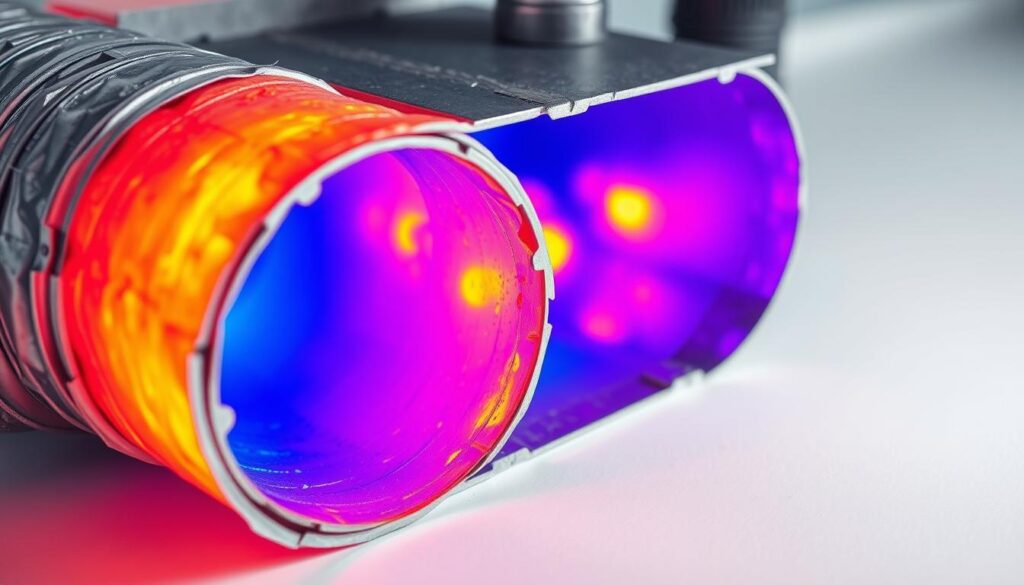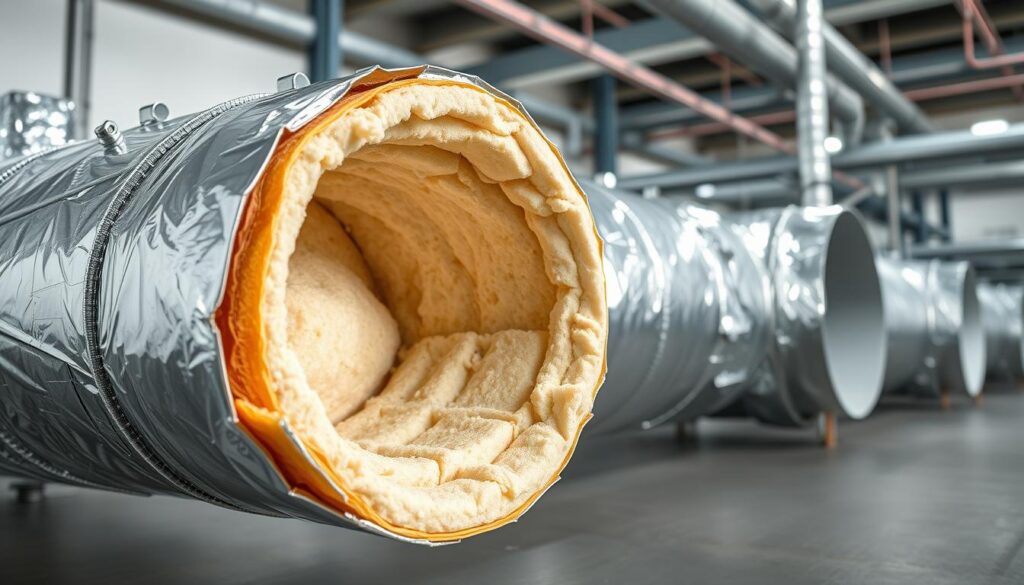Affiliate Disclosure
HVAC Guide Guys is a participant in the Amazon Services LLC Associates Program, an affiliate advertising program designed to provide a means for sites to earn advertising fees by advertising and linking to Amazon.
How Hot Do HVAC Ducts Get? Ever thought about how hot your home’s HVAC ducts get in extreme weather? Knowing about HVAC duct temperature is key to keeping your cooling system running well. It also helps avoid any performance problems.

Air conditioners don’t make “cold” air. They take heat out of the air and send it back through your home’s ducts. The temperature changes in these ducts can really affect how well your system works.
Looking into how hot HVAC ducts can get, it’s important to know that attic temperatures can hit 130°F to 140°F. This is a big challenge for your cooling system. Such high temperatures can make it hard to manage the temperature in your HVAC ducts.
Key Takeaways
- HVAC ducts experience significant temperature variations depending on environmental conditions
- Proper insulation is critical for maintaining optimal duct performance
- Temperature differences can reduce system efficiency by up to 50%
- Regular maintenance helps manage duct temperature challenges
- Understanding duct temperature dynamics improves home comfort
Table of Contents
Understanding HVAC Duct Temperature Basics
Your home’s HVAC system is complex, with ductwork key to comfort. Knowing about duct heat levels and HVAC system temperatures helps improve heating and cooling.
HVAC systems need precise temperature control for best performance. The air’s journey through ductwork is important for system efficiency.
The Role of Temperature in HVAC Systems
Duct temperatures affect your home’s comfort and energy use. Up to 30% of air can escape through poorly designed ducts. This can raise your bills and lower system performance.
- Typical temperature differential: 14-20 degrees Fahrenheit
- Average HVAC system capacity delivery: Only 57%
- Potential temperature variations between rooms: More than 3 degrees
Factors Affecting Duct Temperature
Many things affect your HVAC system’s temperature:
- Duct insulation quality
- Ambient environmental conditions
- System design and configuration
- Ductwork material
Impact on System Efficiency
“Proper duct design and maintenance can improve HVAC efficiency by up to 20%.”
Inefficient ductwork causes big energy losses. Studies show duct systems lose 25% to 40% of heating-cooling energy. Managing duct heat levels can boost your HVAC system’s performance and cut energy costs.
Regular maintenance, proper insulation, and professional duct checks can enhance system efficiency. They help keep indoor temperatures steady.
How Hot Do HVAC Ducts Get: Temperature Ranges Explained
It’s important to know how hot HVAC ducts get to keep your home comfortable. The temperature of these ducts changes a lot. It usually goes from 120°F to 200°F when heating.
When we look at hvac duct temperature, we find some key points:
- Supply air temperatures are usually between 120°F and 140°F when heating
- Cooling cycles have lower temperatures, around 55°F to 65°F
- Delta T (temperature difference) should be between 16-22 degrees Fahrenheit
“Knowing your HVAC duct temperatures can prevent system failures and improve performance.” – HVAC Professional
The temperature of HVAC ducts depends on several things:
- Outside temperature
- Insulation quality
- System age and maintenance
- Specific heating or cooling mode
Pro tip: Regular maintenance keeps your duct temperatures safe and efficient.
It’s important to watch for issues like refrigerant leaks or airflow problems. These can cause abnormal temperature differences. Always get a professional if you see consistent temperature issues in your HVAC system.
Explore Our HVAC Shop
Looking for top-rated HVAC tools, parts, and accessories? Visit our shop and find the perfect solution for your needs.
Visit the ShopSupply and Return Air Temperature Differentials
It’s important to understand how temperatures work in your HVAC system. This knowledge helps keep your system running well and your space comfortable. The difference in temperatures between supply and return air is key to managing airflow and keeping your system at the right temperature.
Experts say there’s a certain temperature gap that’s best for heating and cooling. This gap, called Delta T, should be between 16 and 22 degrees Fahrenheit. This range helps your system work its best.
Optimal Temperature Differences
When checking your HVAC system’s performance, remember these temperature tips:
- A Delta T under 16 degrees might mean your system isn’t working as well as it should.
- Temperatures over 22 degrees could mean there’s a problem with airflow.
- Keeping the temperature difference steady is important for your system’s best performance.
Measuring Supply Air Temperature
To really understand how your system is doing, follow these steps:
- Let the HVAC system run for 15-20 minutes to get the temperatures stable.
- Use a digital thermometer close to the air handler.
- Check the temperature at different supply vents.
- Keep track of any changes in temperature.
“Precision in measurement leads to excellence in HVAC performance.”
Return Air Temperature Monitoring
Watching the temperature of return air is also important for good airflow. Tools like the PRH2 Digital Psychrometer can measure many temperatures at once. This gives you a full picture of how your HVAC system is doing.
Regular upkeep and checks by pros can help keep your system’s temperature differences just right. This ensures your HVAC system runs at its best.
Common Materials Used in HVAC Ductwork
Choosing the right hvac duct materials is key for your system’s best performance. The efficiency of your HVAC system greatly depends on the duct material you pick.
Different materials have different levels of heat resistance and performance. Let’s look at the most common ones:
- Sheet Metal Ducts: Made from galvanized steel or aluminum
- Non-porous, preventing mold growth
- Lightweight and easy to install
- Cost-effective solution
- Flexible Ducts: Made with wire helix and polymer plastic
- Adaptable to complex layouts
- Lower installation costs
- Requires professional installation
- Fiberboard Ducts: Compressed resin with glass fibers
- Excellent acoustic properties
- Self-insulated
- Shorter lifespan compared to metal ducts
“The right duct material can save up to 30% on heating and cooling expenses.” – HVAC Engineering Insights
For the best heat resistance, sheet metal is the top choice. Each material has its own benefits. Pick the one that fits your HVAC system’s needs and your budget.
Temperature Impact on Different Duct Materials
Your HVAC system’s performance depends a lot on the heat resistance of its duct materials. It’s important to know how different materials handle temperature changes. This helps keep your heating and cooling system efficient and lasting longer.
Choosing the right hvac duct materials is key to managing heat and keeping your system efficient. Each material reacts differently to temperature changes.
Metal Duct Heat Resistance
Sheet metal ducts are very good at handling heat. They can handle temperatures up to 130°F. They are durable and have smooth surfaces, which helps air flow better.
- Durability under high temperatures
- Smooth interior surfaces reducing air resistance
- Potential efficiency improvements of up to 20-30%
Flexible Duct Temperature Limits
Flexible ducts can’t handle as much heat as metal ducts. They can break down faster under extreme heat. They are best for areas with moderate temperatures.
- Lower heat resistance compared to metal ducts
- Higher risk of material degradation
- Recommended for areas with moderate temperature ranges
Insulation Material Performance
Good insulation is key to keeping duct temperatures right. It can cut down heat transfer by 10-15%. This leads to big energy savings and better system performance.
“Choosing the right duct material and insulation is not just about temperature resistance, but about overall system efficiency and longevity.”
Knowing how different duct materials handle heat helps you make better choices. This improves your HVAC system’s performance and lifespan.
Explore Our HVAC Shop
Looking for top-rated HVAC tools, parts, and accessories? Visit our shop and find the perfect solution for your needs.
Visit the ShopManaging Duct Heat Levels Through Proper Insulation

Understanding duct thermal insulation is key for a good HVAC system. Your home’s comfort and energy use depend on it. How well you manage duct heat levels matters a lot.
Good insulation stops heat loss and gain. This makes your indoor air more stable. The right insulation can cut your energy bills by up to 30% and boost system efficiency.
“Effective duct insulation is like a protective shield for your HVAC system, keeping temperatures consistent and energy consumption low.”
When managing duct heat levels, consider these:
- Selecting the right insulation materials
- Knowing what R-value you need
- Finding where heat can sneak in
- Using thorough sealing methods
Different insulation types have their own perks:
| Insulation Type | R-Value | Temperature Range |
|---|---|---|
| Fiberglass | 2.9-4.3 per inch | 0˚F to 450˚F |
| Reflective Insulation | 5-15 | -20˚F to 300˚F |
| Eco-Friendly Cotton | 3.5-4.0 per inch | -10˚F to 250˚F |
Experts say check your ductwork every 3-5 years. Regular maintenance can greatly cut energy waste and make your HVAC system more efficient.
Temperature Variations in Different HVAC Zones
Knowing the temperature differences in your home can make it more comfortable and save energy. The temperatures set on your HVAC system are key to a balanced home.
Many homes have uneven heating and cooling. This can be due to several reasons affecting how air flows through ducts.
Identifying Hot and Cold Spots
There are many reasons for temperature differences:
- Multi-level homes can have uneven heating
- Rooms with big windows can get too hot or cold
- Not enough insulation can cause problems
- Badly designed ductwork can also be a problem
Balancing System Temperatures
Zoned HVAC systems are a good solution. They let you control the temperature in different parts of your home.
| Zoning Benefit | Potential Savings |
|---|---|
| Energy Cost Reduction | Up to 30% |
| Individual Room Control | Customized Comfort |
| Installation Cost | $1,700 – $4,500 |
Zone Control Solutions
Today’s zoning technology offers new ways to manage temperatures:
- Using many thermostats for better control
- Electronic dampers for better airflow
- Smart home integration
- Compatibility with variable speed systems
“Zoned HVAC systems transform how we experience home comfort by providing personalized temperature control.” – HVAC Expert
By managing temperature differences, you can make your home more comfortable and save energy.
Heat Loss and Gain in Ductwork Systems
Knowing about duct heat levels is key to a good HVAC system. Your home’s ductwork faces big thermal challenges. These can really affect how much energy you use and how comfortable you feel.
Duct thermal insulation is very important for controlling heat. Studies show that heat loss happens fast, mainly in the first few feet from the wall to the ground. If heat gain or loss isn’t controlled, it can cause big energy waste.
“Proper duct insulation can save consumers up to 30% on energy costs.”
- Typical duct temperatures can range from 56°F to 300°F during operation
- Energy waste occurs through uncontrolled heat transfer
- Proper insulation helps maintain consistent air temperatures
There are key temperature insights for managing heat:
| Temperature Condition | Impact on HVAC System |
|---|---|
| Winter Optimal Duct Temperature | 65°F (18°C) |
| Maximum Floor Temperature | 52°F (11°C) |
| Summer Interior Temperature Control | Prevent exceeding 82°F (28°C) |
By using smart duct thermal insulation, you can cut down on energy use a lot. High-efficiency ENERGY STAR gas furnaces show better thermal performance. They help keep indoor temperatures steady and reduce heat gain.
Explore Our HVAC Shop
Looking for top-rated HVAC tools, parts, and accessories? Visit our shop and find the perfect solution for your needs.
Visit the ShopTemperature Control Methods for HVAC Ducts
Keeping the temperature in HVAC ducts just right is key for comfort and saving energy. Today’s HVAC systems have new ways to control the temperature with great accuracy.

Advanced Temperature Regulation Techniques
Modern HVAC systems use advanced tech for better temperature control. These new methods improve how well ducts work and save energy.
- Variable-speed blower systems
- Multi-stage heating and cooling
- Zonal temperature management
Smart Control Systems
Smart temperature control uses the latest sensors and algorithms. These systems adjust the duct temperature as needed. They can:
- Watch environmental changes in real-time
- Adjust based on who’s around
- Use less energy
Maintenance Requirements
Keeping your system running well needs regular checks. Experts say to have your ducts checked often to keep them cool.
“Proactive maintenance prevents costly system failures and maintains peak efficiency.”
| Maintenance Task | Frequency | Purpose |
|---|---|---|
| Duct Inspection | Annually | Check for leaks and temperature inconsistencies |
| Filter Replacement | Every 3-6 months | Maintain airflow and system efficiency |
| Sensor Calibration | Biannually | Ensure accurate temperature readings |
Investing in advanced temperature control methods can significantly improve your HVAC system’s performance and longevity.
Signs of Overheated Ductwork
It’s important to know how hot your HVAC ducts get to keep your home comfortable and safe. Spotting overheated ductwork signs can stop damage to your HVAC and save you money on repairs.
Duct heat levels tell a lot about your system’s health. Look out for these signs of overheating:
- Unusual burning odors coming from vents
- Unexplained spikes in energy bills
- Visible damage to duct materials
- Frequent system cycling
- Inconsistent room temperatures
Your HVAC system sends out warning signs. A burning smell is often the most critical red flag. It means your ducts might be too hot.
“When your ductwork speaks, listen carefully. The signs of overheating can save you thousands in possible repairs.” – HVAC Professional Insight
Watch out for these critical temperature warning signs:
| Warning Sign | Potential Cause | Recommended Action |
|---|---|---|
| Burning Odor | Potential Overheating | Immediate System Inspection |
| Frequent System Cycling | Temperature Regulation Issues | Professional Diagnosis |
| Uneven Heating | Airflow Restrictions | Check Ductwork and Filters |
Regular maintenance can stop up to 80% of HVAC failures due to overheating. Keep an eye on your system’s performance and fix any odd signs quickly. This ensures it works well and safely for a long time.
Explore Our HVAC Shop
Looking for top-rated HVAC tools, parts, and accessories? Visit our shop and find the perfect solution for your needs.
Visit the ShopModern Solutions for Duct Temperature Management
New technologies are changing how we cool and manage air in homes. Homeowners can now use advanced systems that control temperature better and save energy.
“Smart technology is transforming how we manage indoor climate control,” says HVAC industry expert Dr. Rachel Chen.
Modern ways to manage duct temperatures include:
- Adaptive cooling systems with real-time temperature monitoring
- Smart home integration for precise temperature control
- Advanced predictive maintenance algorithms
- Energy recovery ventilation technologies
Today’s HVAC tech aims to improve air flow management with smart systems. Homeowners can use digital tools to better control temperature and cut down on energy use.
| Technology | Energy Savings | Performance Improvement |
|---|---|---|
| Variable Speed Motors | 30-50% | Enhanced Airflow Control |
| Smart Thermostats | 20-30% | Precise Temperature Management |
| Predictive Maintenance | 25-30% | Extended Equipment Lifespan |
Using these modern solutions can greatly improve your home’s cooling, lower energy bills, and make it more comfortable. The future of HVAC technology is here, bringing smarter and more efficient ways to manage temperature.
Conclusion
Knowing about HVAC duct temperature is key to a comfy and efficient home. You’ve learned how managing temperature affects your heating and cooling systems. Today’s HVAC tech offers advanced ways to improve duct performance and save energy.
Understanding HVAC duct temperature helps you make better choices for your system. Keeping duct heat levels right can cut energy costs by 20-30%. Now, 60% of air duct systems do both heating and cooling, giving you better climate control.
Keeping your HVAC system in top shape is essential. Regular checks, good insulation, and knowing about temperature changes can make your system last longer. Air duct heaters can last 15 to 25 years, making a smart investment for your home’s comfort and energy use.
As HVAC tech gets better, knowing about duct temperature management is more important. It helps you create a more comfortable, efficient, and cost-effective home. You now have the power to make choices that improve your home’s performance and comfort.

